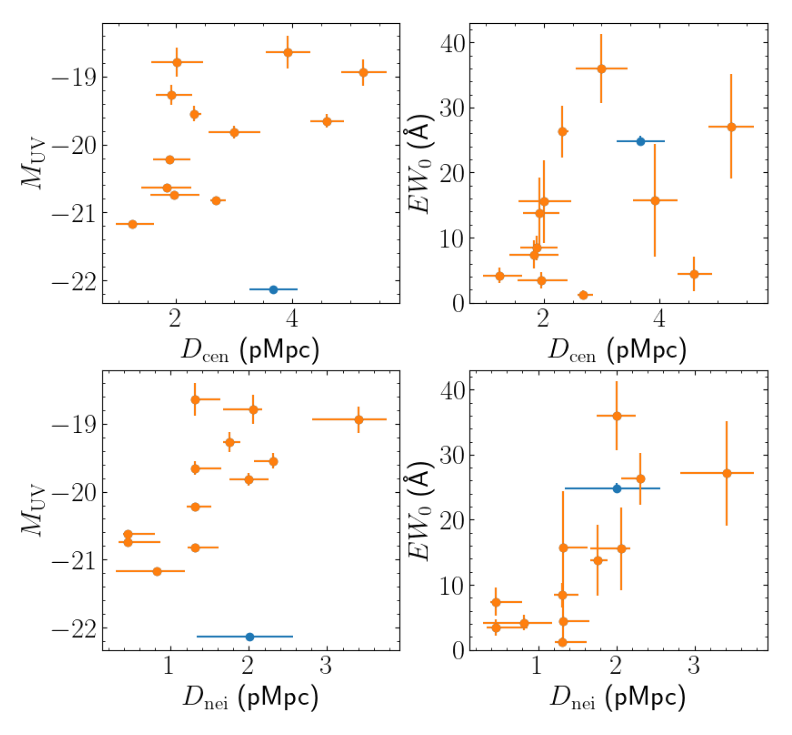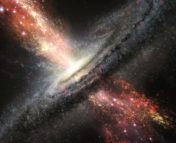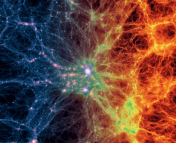Title: Galaxy properties from the outskirts to the core of a protocluster at z=3.699
Authors: Jun Toshikawa, Stijn Wuyts, Nobunari Kashikawa, Hisakazu Uchiyama, Malcolm Bremer, Marcin Sawicki, Yoshiaki Ono, Mariko Kubo, Kei Ito
First Author’s Institution: Nishi-Harima Astronomical Observatory, Center for Astronomy, University of Hyogo, Japan
Status: Submitted to MNRAS [open access]
Currently, astronomers studying galaxies are facing a nature vs. nurture question: how does a galaxy’s environment affect how it grows up? This is especially pronounced in the most extreme environment a galaxy can find itself in: a galaxy cluster, or a large, gravitationally-bound group of hundreds to thousands of galaxies. Galaxies in clusters have properties that are distinct from galaxies outside of clusters, suggesting that they grew up in different ways. For example, in the more local universe (redshifts < 0.5, or less than 5 billion years ago), galaxies in clusters have almost entirely stopped forming new stars due to the effects of being in such a dense environment. Exactly when these effects begin, and how star formation works in clusters before this time, is less clear.
Building a Galactic Community
In today’s paper, the authors look back in time to the very earliest stages of galaxy cluster formation – they investigate a protocluster at redshift 3.699 (11 billion years ago). One issue with studying protoclusters is that they’re very hard to find – finding galaxies clustered together in all three dimensions requires a large, detailed survey of galaxies. It’s straightforward to find galaxies that appear close to each other on the sky (in the two angular dimensions), but the radial, or line-of-sight, dimension is much harder. This is because the typical method for finding the distance to a galaxy is to use its redshift, which is calculated from spectral lines in the galaxy and thus requires spectra. Unfortunately, it’s very time-consuming (and expensive) to perform a large spectroscopic survey.
Finding Protoclusters
One way astronomers work around this is by using a photometric technique known as the dropout method (e.g. this astrobite), which takes advantage of the fact that the UV radiation emitted by a distant galaxy is absorbed by neutral hydrogen on its way to the Earth. Because of this effect, when you observe a galaxy from the Earth in wide-band images at increasingly shorter wavelengths, it appears to suddenly vanish. This ‘dropout’ happens at a very specific wavelength, so it can be used to estimate the redshift of a galaxy. The technique only requires imaging (‘photometry’), so it’s a lot more economical.
The Follow-Through
Today’s paper is actually a follow-up to a dropout survey – the authors identified 210 galaxies that appeared to be clustered together in a previous photometric survey. In this paper, they’re describing the results of going back and measuring each of those galaxies spectroscopically. They use a multi-object spectrograph instrument on the Keck telescope and target the Hydrogen Lyman-alpha (Lyα) emission line. They detect emission lines in 68 of the 210 galaxies in their sample. Of these, 13 are extremely close in redshift, with a spread of less than 0.05. The probability of this happening by chance at a redshift of 3.699 is less than 0.5%. The cluster is shown in Figure 1.

Investigating the Community
After finding these galaxies, the authors begin to look at their relationships to each other. In particular, they investigate two quantities: the UV magnitude of the galaxy (how bright it is in UV wavelengths) and the equivalent width (a measure of spectral line strength) of the Lyα emission line. They look for correlations in these quantities as a function of two different indicators of the galaxies’ environments: the distance from the galaxy to the center of the protocluster (Dcen), and the distance from the galaxy to its nearest neighbor (Dnei). Plots of these relationships are shown in Figure 2.

Talking to your Neighbors
The conclusion here is very interesting – for a cluster this early in its lifecycle, it’s actually not the distance to the cluster center that matters. Instead, the galaxy properties are correlated with the nearest neighbor distance. This suggests that the authors have caught this cluster too early for the overall cluster of galaxies to matter that much. Instead, galaxies are affecting each other directly. If this proves to be the case in general, it would mean that star formation activity is more sensitive to the small-scale environment surrounding the galaxy than to the cluster as a whole, at least as the cluster is being formed. This supports a bottom-up, or hierarchical picture of how the universe is formed.
These are still very small number statistics (with only 13 galaxies having been detected), and this is only one protocluster. It’s a little too early to say if this is happening everywhere, and obvious next steps for the authors include exploring this relationship in other protoclusters. Still, this is an exciting look into how galaxies talk to each other while forming the largest structures in the universe.
Astrobite edited by William Smith
Featured Image Credit: NGC 1300: NASA, ESA, and The Hubble Heritage Team STScI/AURA), NGC 4414: The Hubble Heritage Team (AURA/STScI/NASA); NASA Headquarters – Greatest Images of NASA (NASA-HQ-GRIN)




